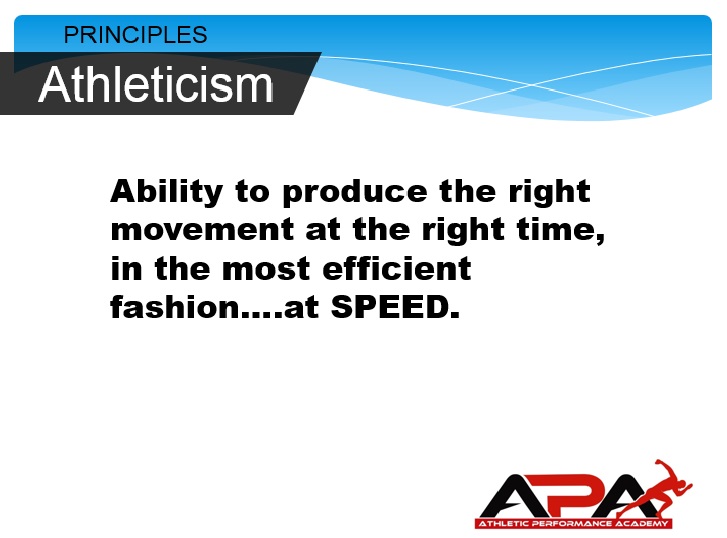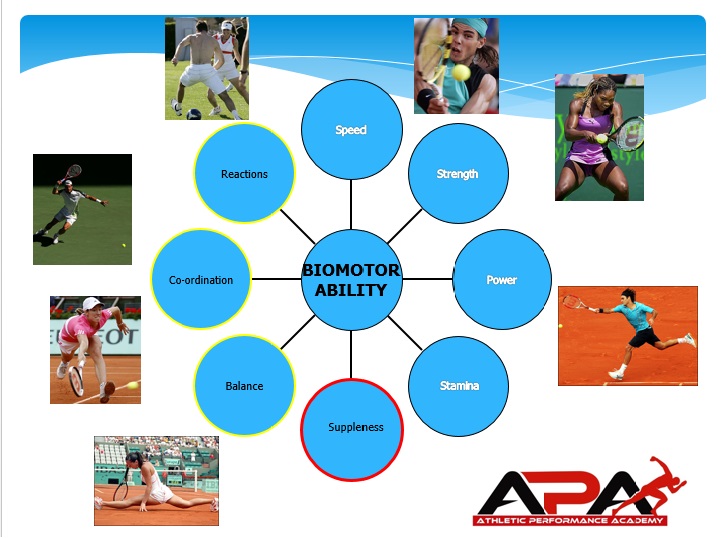Last weekend I had the privilege to speak to a group of coaches at my latest workshop, ‘Coordination and Strength training for Sports.’
One of the first questions I asked the group was,
‘What is athleticism, and what does it look like?’
I got some really interesting feedback and a lot of great descriptions of qualities the coaches associated with it such as:
- Rhythm
- Smooth
- Bouncy
- Use all the muscles
- Alert
I then asked them to give me a definition of it which was a bit more tricky so I offered the group my own defintion of what it means to be athletic
athleticism
Also found in: Medical, Encyclopedia, Wikipedia.
ath·let·ic
(ăth-lĕt′ĭk)
My personal definition of athleticism is below.
Then I showed them a couple of video clips of someone who I thought was athletic (F2 football free-stylers) and someone who was not (comedy imitator football free-styler Tyler Swift). Check out the videos below:
To me athleticism can really be defined by the APA 5 S’s of Fitness:
- Suppleness
- Skill
- Speed
- Strength
- Stamina
In many people’s minds being athletic is associated with being strong and muscular. A lot of attention is put on getting athletes fitter, faster and stronger and rightly so. But for me these are qualities are build on foundations of suppleness and skill. A lot of people associate skill with being something that a sports coach develops, it’s not the job of an Strength & Conditioning coach. Well I would challenge that assumption.
What does it actually mean to be ‘Skilful?’ Certainly some of the words that the coaches came up with such as Rhythm, Smooth and Alert might be appropriate definitions of Skilful. And are we referring to skilful movement, skilful execution of a sports skill or both?
I have previously written a blog about the difference between movement skills and sport skills. I think you need to work on both in unison, but there can be no doubt that you cannot as effectively execute sports skills without a sound base of movement skills.
Movement Skills
When referring to movement skills I like to refer to three categories:
- Coordination
- Balance
- Reaction speed
Coordination:
Locomotion- skills that get you from place to place such as running, jumping, hopping
Manipulation- skills that involve sending and receiving objects using your limbs and external equipment
Balance:
Static-staying still by keeping head and shoulders level and within width of feet
Dynamic- losing and regaining balance during activity that involves constant changes to your body position
Reaction Time:
the time involved in recognising the need to make a decision and actually starting to execute the decision
I have included three videos below to give an example of balance, coordination (locomotion and manipulation) and reaction speed.
Session Planning
In terms of putting together these components into session plans I like to break up my sessions into gym based and field based sessions. The gym based movement skills focus on Suppleness and Strength. The field based sessions focus on Skill and Speed. Stamina can be incorporated into both.
Field based session:
Warm-up– will include aspects of balance and coordination, and typically can finish with reaction speed.
I personally like to talk about mindful practice so all elements can introduce reaction speed by way of introducing decision making as frequently as possible.
Main Session– will include further aspects of skill development.
- Main Skill Development- usually choose from coordination, balance or reaction speed
- Main Speed Development- usually choose from Straight ahead speed, First step speed or Multi-directional speed
Hope that gives you some ideas of how to develop a movement based programme that can support development of Skill.
- If you’re not subscribed yet, click here to get free email updates, so we can stay in touch.
- Share this post using the buttons on the top and bottom of the post. As one of this blog’s first readers, I’m not just hoping you’ll tell your friends about it. I’m counting on it.
- Leave a comment, telling me where you’re struggling and how I can help




